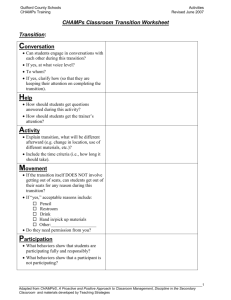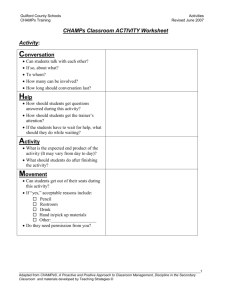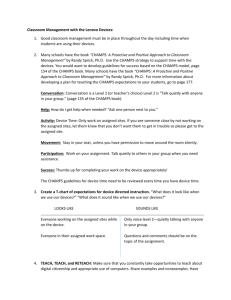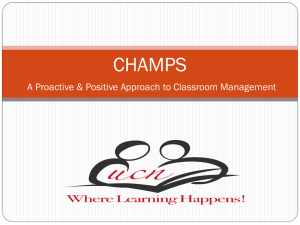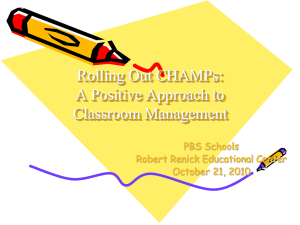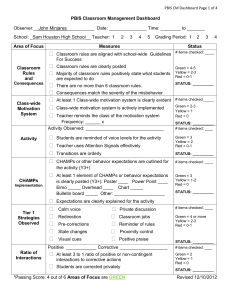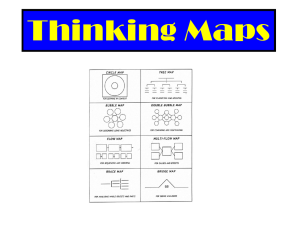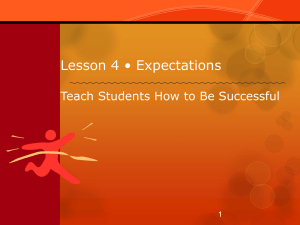champs - Utah Personnel Development Center
advertisement
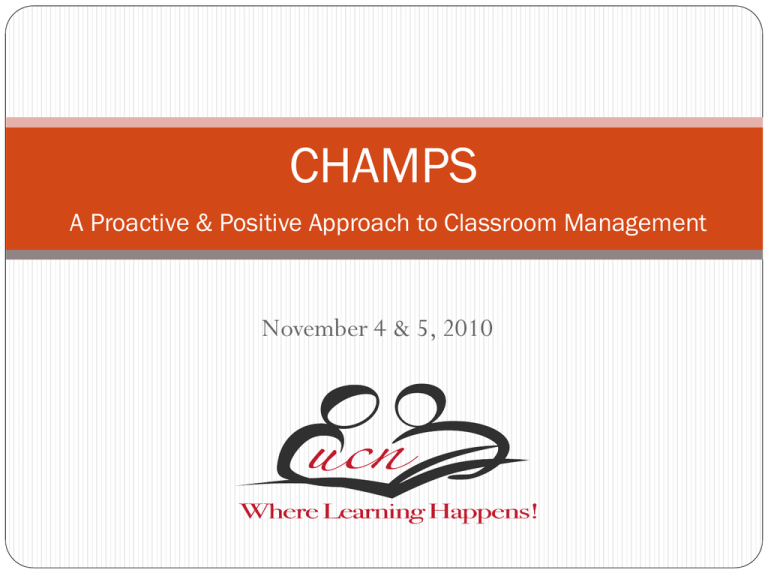
CHAMPS A Proactive & Positive Approach to Classroom Management November 4 & 5, 2010 Objectives Provide an Overview of Behavior Know the ABC’s for Behavior Expectancy X Value Equation What the Effective Schools Research Shows: Effective Teachers Establish smooth efficient classroom routines Directly teach students how to be successful Interact with students in positive, caring ways Provide incentives, recognition, and rewards to promote excellence Set clear standards for classroom behavior and apply them fairly and consistently PBIS/RtI: 3Tiered Prevention Model 5% 15% 80% of Students Tertiary Prevention: specialized & individualized strategies for students with continued failure Secondary Prevention: supplementary strategies for students who do not respond to primary Primary Prevention: school-wide or class-wide systems for all students and staff 4 Components of PBIS PBIS Positive Behavior Intervention and Support Tiered Behavioral Instruction and Intervention Proactive, Preventative, Efficient Establish Explicity Teach Reinforce Correct Expectations Expectations Expectations Behavioral Errors All Areas All Areas All Areas All Areas All Staff and Students All Staff and Students All Staff and Students All Staff and Students Why does behavior occur? To get or obtain something or Escape or Avoid something. This is also known as…. Positive reinforcement – To get something Negative reinforcement – To avoid something Sally sits next to Simon. Simon sticks his pencils up his nose and makes animal noises only when Sally sits beside him. Sally giggles. What is the motivation for Simon’s bizarre behavior? A. Avoid task or activity B. Obtain peer attention C. Avoid Adult Modified from Scott, Liaupin and Nelson (http://serc.gws.uky.edu/pbis/) Mr. Feeble asks Ralph to take out his math book. Ralph responds, “Your mother wears combat boots.” Mr. Feeble then sends Ralph to sit in the hall instead of doing math What is the motivation for Ralph’s rude comment to Mr. Feeble? A. Avoid task or activity B. Avoid Peer(s) C. Obtain adult attention Modified from Scott, Liaupin and Nelson (http://serc.gws.uky.edu/pbis/) 4 Expectancy X Value = Motivation Page 28 Expectancy Rate X Value Rate = Motivation 10 X 10 = 100 10 X0 =0 0 X 10 =0 Objectives Participants will know what STOIC means Participants will know what CHAMPS means Participants will understand the components of the CHAMPS curriculum CHAMPS Overview Page 3 & 4 Page XV Chapter 1 Page 15 Chapter 2 Page 63 Chapter 1 Page 61 Find the SELF ASSESSMENT for Chapter 2 – what Page? Closed Book Review What does STOIC stand for? What does CHAMPS stand for? Each chapter starts with a list of T_________ Each chapter ends with a S_____ __________ Next Objectives STRUCTURE Chapters 1-3 Know the various components of classroom management & a classroom management plan. Know steps and procedures for implementing various components with fidelity Evaluate and distinguish between effective and ineffective classroom expectations. Strategies for addressing problem behavior in the classroom vs. when to refer the student to the office. Group S#^%% - No Book What are the components of classroom management that add STRUCTURE to your classroom? Many STAY but 2 must STRAY. Compare Yours with Others Page 195 – 200 CHAPTER 2 PAGE 63 Task 3 Task 4 Possible Task 6 Attention Signal Task 3 Pg 76-78 Signal can generalize to any location Visual and auditory cue Has ripple effect Attention Signal Task 3 pg. 76-78 Identify what you will use as a signal Define expectation for student responding Stop talking Look at teacher Put hand in air Observing/Coaching Attention Use coaching model (pre, observation, post) Consider the Teachers task (Attention Signal) Analyze the Teachers task (break it down into logical & sequential steps) Observe Structure & Provide feedback Beginning & Ending Routines Task 4 page 78 - 89 Review pages Identify 7 critical times and issues Identify goal statements for each Ending Routines Partner 1 & 2 1 Reads Procedures for end of day (pg 88) 2 reads Dismissal (pg 89) Partner 1 share Partner 2 share Group S#^%% Coaching Application: Table Time Teacher request help with her ending routines. What questions would you ask in the pre conference? Dismissal Routine Group S#^%% Coaching Application: Table Time After observing the ending routine – What suggestions do you have? How would you share your suggestions? What would be your next step? Example Teacher Prepared students for change (ie. In 30 seconds…) YE S NO Notes Attention Signal delivered YES NO Notes Gave expectation for routine YES NO Notes Pre-corrected problem behavior and reviewed expectations (clean, seat, wait quietly) YES NO Notes Teacher provided feedback to class before YES dismissing NO Notes Teacher dismissed class NO Notes YES Develop Ending Routine CHAPTER 3 PG 107 Task 2 Task 3 Task 4 Task 5 Teacher structures the development of the classroom rules. Students tend to be… Too punitive They generate too many They are not specific Tough kids do not like to follow other kids rules. Teachers tend to be… More specific More consistent with all students More realistic expectations for classroom behavior Based on general education expectations. Classroom Rules Ch 3 Task 2 pg 116 Rules should be stated positively Rules should be specific and refer to observable behaviors Teach your rules using positive and negative examples Applicable throughout the entire class period Posted in a prominent, visible location. Group S#^%% Evaluate the following set of Rules What changes would you make What additions? What deletions? Be prepared to share with whole group. Example Set of Rules Sit in your seat unless you have permission to leave it. Do what your teacher asks immediately Pay attention Be ready to learn Don’t hit others Example Set of Rules Follow Directions the First Time Keep Eyes on Task or Speaker Be in Your Seat with Materials When Bell Rings Keep Hands, Feet and Objects to Self Correcting Rule Violations Ch 3 Task 3 Page 119 – 126 VS Task 4 Page 126-139 Anticipate Problem Behavior Pre-correct Problem Behavior (Pg.120) Develop a Plan Follow the Plan Positive environments, Dianna Browning Wright Diagnostic Center, Southern California COMPARISON OF PUNITIVE METHODS AND POSITIVE APPROACHES PUNITIVE PROCEDURES POSITIVE APPROACHES 1. Rapidly stops behavior 1. Slowly stops behavior 2. Provides immediate relief to teachers Teaches the student and peers what not to do Decreases positive self concept Decreases positive attitudes towards school and school work Causes withdrawal (non-task, tardy, truancy drop out) Causes aggression (against property and others Teaches students to respond in a punitive manner 2. Provides no immediate relief to teacher Teaches the student and peers how to behave Increases positive self concept Increases positive attitudes towards school and school work Promotes enhanced participation Decreases likelihood of aggression Teaches students to recognize the positive 3. 4. 5. 6. 7. 8. Results in suppression of undesirable behaviors, not elimination 3. 4. 5. 6. 7. 8. Results in alternative, positive behavior to replace maladaptive behavior. Behavior and Educational Strategies for Teachers, Utah State Office of Education. Reavis Rhode Jenson (1992) What If? Chart WHAT IF YOU DO? WHAT IF YOU DON’T? SEVERE BEHAVIOR CLAUSE ? Hierarchy of Negative Consequences Close the gap Proximity Praise MILD BEHAVIOR Precision Request •Mild and inconveniencing Consequence + minor incident report MODERATE BEHAVIOR •Increase the consequence slightly •Increase or add another level of consequence •Emergency or Severe Clause for major rule infractions SEVERE BEHAVIOR Secondary Example HOW TO IMPLEMENT If you talk – time starts over If you walk out without paying time = time doubles If you reach 6 min of time owed = Office referral Parent conference lunch detention WHAT IT LOOKS LIKE Proximity Praise Please –Warning 1 Need –Warning 2 Skill Builder Change Seat assignment + minor incident report/name in consequence book :30 seconds 1:12 1:28 2:07 Group S#^%% Groups Use Poster Paper Divvy the following: 1 Time Out (another class) pg 132 2 Response Cost pg 133 3 Behavior Improvement pg 134 4 Demerits pg 135 ANSWER THE FOLLOWING: What does it look like? How to Implement? Group S#^%% Continued Jig Saw Sharing At your table Count off from 1-6. after 6 start over at 1 until everyone has a number from 1-6 1’s go to poster 1 2’s go to poster 2 etc… If its your poster, you share with group. Rotate to next poster at signal Quick Review of STRUCTURE Name 1 component of the classroom management plan Name 1 behavior that should be addressed in the classroom Name 1 strategy for addressing mild problem behavior in the classroom. Name 1 strategy for addressing moderate problem behavior in the classroom Next Objectives: TEACH – Chapter 4 pg 147 Define CHAMPS expectations for instructional activities Define CHAMPS expectations for transitions Develop lesson plans for teaching expectations. Examples of CHAMPS Worksheets Instructional Activities Review pages 157 - 164 Quiz on CHAMPS Instructional Activities During Individual written tests, how do students get help? Put your finger on the answer Instructional Activities Make a list of your different instructional activities. Compare with your neighbor Compare with page 151 Instructional Activities Pick one activity Complete a CHAMPS worksheet Use examples as a model Examples of CHAMPS Worksheets Transitions Review pages 168 – 177 Quiz on CHAMPS Transitions What is the expectation for Activity during “Clean up at end of day”? Put your finger on the answer Adaptations Adapting CHAMPS for young children pg 180 MAC Adapting CHAMPS for Older Students – pg 181 ACHIEVE Teach students how to behave responsibly in the classroom Three-Step Process for Communicating Expectations Group S#^%% Jig Saw 3 Step Process Groups of 3 1 takes STEP 1 pg 209 2 takes STEP 2 pg 210 3 takes STEP 3 pg 211 At signal 1 will share Rotate at next signal Teaching Expectations Use the following documents from last year Explicit Instruction Lesson Plan Template pg 23 packet Basic 5 & Instructional Routines & Data Summary pg 25 & 26 of packet What is involved in the act of Teaching? Does CHAMPS have an Instructional Routine built into the program? High Structure Lessons pg 185 Show Classroom Expectations Tell Students what you expect Provide rationale for expectation Model examples of expectation Have some students demonstrate Model Non-examples Model the correct way one more time Mix up examples and non examples and have students verify they understand Review all positive examples with students Students write/Draw the rule with example and non example Move on to next. Tips for Teaching Expectations Rules to Teach When to Teach % of Class period All Rules Day 1 100 % Rule # 1 & Review All 5 Day 2 40 % Rule # 2 & Review All 5 Day 3 40 % Rule # 3 & Review All 5 Day 4 40 % Rule # 4 & Review All 5 Day 5 40 % Rule # 5 & Review All 5 Day 6 40 % Review 1 - 2 Day 7 25 % Review 3 - 5 Day 8 25 % Review all 5 Day 9 10 % Review all 5 Day 10 10 % Random Review Day 11+ 7-10% Observing/Coaching Teach How does the teacher know if students understand the expectations? As a Coach – How can you help in this process? Group S#^%% CASE STUDY – Group of 8 Review the case study for Mr. Jepson Discuss possible recommendations – See page 99 Keep track of additional questions you may have. Group S#^%% cont. CASE STUDY Within 8 - Split group in half. Group 1 = Instructional Group 2 = Facilitative Use pages 32 & 33 –Review Develop a plan How will you start the conversation How specific will you be when sharing data How and when will you gather additional data How will you share your suggestions? Group S#^%% cont. CASE STUDY Within 8 - Split group in half. Group 1 = Instructional Group 2 = Facilitative Use pages 32 & 33 –Review Develop a plan How will you start the conversation How specific will you be when sharing data How and when will you gather additional data How will you share your suggestions? Quick Review of TEACH C Stands for? H Stands for? A Stands for? M Stands for? P Stands for What is one question you could ask a student to check for their understanding? Interact Positively –pg 278 What is Non-Contingent Attention? Pg 278 What is Contingent Attention? Task 2: Provide Positive Feedback pg 283 I – Immediate F – Frequent E – Eye contact E – Enthusiastic D – Descriptive A – Build anticipation V – Vary your feedback When Students Respond Negatively to Positive Feedback pg 298 Treat the misbehavior as a momentary interruption of student success At a neutral time, talk to student about the students tendency to misbehave after getting positive feedback Find a way to give positive feedback more privately Switch from giving specific descriptive feedback to simply interacting with the student when behaving responsibly. Task 3: Provide Intermittent Celebrations Periodically reward both individual and whole class with a celebration that acknowledges their progress and success in meeting behavioral and academic goals. Review list on page 297. Add to list Task 4: Strive to Provide a High Ratio of Positive Interactions 3:1….. Plan to interact at least 3X more often with each student when they are behaving appropriately than when he or she is misbehaving. Ratio of Interactions Monitoring Form Positive Interactions Negative Interactions IIIII II Activity: Pick your most Activity: Pick your most Use the problem solving Use the problem solving difficult class period and make tally marks for positive interactions model to change your ratio difficult class period and make tally marks for negative interactions model to change your ratio Next Steps Assignment for CHAMPS Tonight’s Assignment Down the road How to get everyone on the same page? How to speak a common language? What additional steps need to happen or can happen? Go Green!
